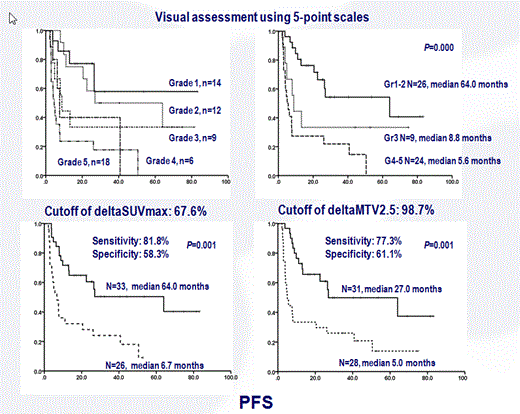Abstract
Although interim 18F-fluoro-2-dexoy-D-glucose-positron emission tomography (FDG-PET)/computerized tomography (CT) scan has emerged as a powerful prognostic tool in predicting treatment outcome in Hodgkin's lymphoma (HL) and diffuse large B cell lymphoma (DLBCL), the prognostic value of interim PET/CT scanning has not been determined in peripheral T cell lymphomas (PTCLs). We prospectively investigated the sequential interim PET/CT to determine whether it provided additional prognostic information for the treatment of PTCLs.
Sixty-three patients with newly diagnosed PTCL were enrolled from Sep. 2006 to Nov. 2011 (ClinicalTrials.gov Identifier: NCT01470066). PET/CT scan was performed at the time of diagnosis, mid-treatment and the completion of CHOP/CHOP-like or non-anthracycline-based chemotherapy. The initial stage and final response were assessed according to the revised International Workshop Criteria (IWC). The response of interim PET/CT was assessed by combined evaluation with visual analysis using Deauville five-point scale (5-PS), quantitative assessment of the maximal standardized uptake value reduction rate (delta SUVmax) and quantitative assessment of metabolic tumor volume reduction rate (delta MTV2.5). To evaluate the optimal cutoff value of delta SUVmax or delta MTV2.5 for predicting the disease progression, receiver-operating characteristic (ROC) analysis was performed.
Median age was 60 years (range: 20-81). 39 patients (61.9%) presented with advanced stage and 18 (28.6%) had bone marrow involvements. The histological subtypes were 27% PTCL-unspecified (n=17), 15.9% AITL (n=10), 42.9% NK/T cell (n=27), and others. At diagnosis, 31 patients (49.2%) were classified as high-risk by the international prognostic index (IPI) and 29 (46%) were classified as high-risk (more than 2 factors) by the prognostic index for PTCL (PIT). 59 patients could be evaluated for the interim response with 7.9% of treatment-related mortality. After following median 40.3 months (range, 12.8-83.2), more than grade 3 in Deauville 5-PS, the optimal cutoff value of delta SUVmax and the optimal cutoff value of delta MTV2.5 could differentiate the patients for predicting the disease progression with high positive predictive value (87.8%, 92.3% and 92.8%, respectively). Patients with more than grade 3 based on 5-PS had significantly poor prognosis compared to patients with grade1-2 (P=0.000). In addition, the 3-year PFS rates were significantly different between patients with delta SUVmax°Â67.6% or delta MTV2.5°Â98.7% and patients with above the optimal cutoff value of delta SUVmax or delta MTV2.5, respectively (P=0.001). Seven patients with interim PET-positive uptakes (more than grade 3) were revealed with false-positive uptakes and three patients were with false-negative by locoregional biopsy.
The visual, quantitative SUV-based and MTV-based assessment in mid-treatment interim PET/CT had a significant predictive value for disease progression and three parameters could have a high differential potential for predicting the prognosis in patients with PTCLs.
No relevant conflicts of interest to declare.
Author notes
Asterisk with author names denotes non-ASH members.


This feature is available to Subscribers Only
Sign In or Create an Account Close Modal